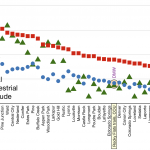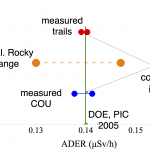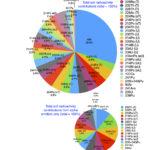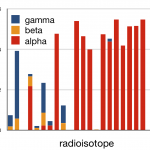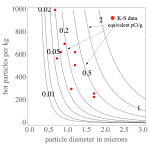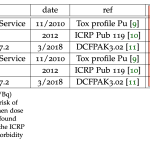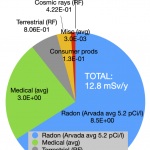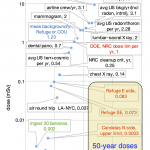In physics (where quantities have units) there are no large quantities: one is large only in comparison to another with the same units. To a physicist, then, the first question that arises about a radiation dose is not "how big is it?" It is "What is the background radiation dose"? As a result, the sensible way to look at any radiation dose (say, per year) is to compare it with what you already receive naturally (per year), as part of 'background radiation'. Historically it has been very difficult to demonstrate any health effects from background radiation, even in areas around the world where it is very high.
It is possible to understand the negligible risks of living around Rocky Flats graphically. Here we attempt this. Below are galleries of images. If you click on an image, you'll see one image at a time so you can page through them using the back/forward control arrows. Mash ESC (the escape key) to exit the gallery.
A brief explanatory paragraph is shown in blue and follows each gallery; in the right margin are footnotes for the interested.
Radiation levels and soil contributions
[ABOVE} Plutonium is a trace radiation source in Rocky Flats soil: Measured radiation levels on Refuge trails and in the off-limits COU: (i) are just what they should be for background radiation in the area [lower than in Boulder], (ii) reproducible by very different measurement methods. Whatever Pu contributes, it is smaller than inter-city variations in background radiation. (iii) National Institute of Standards and Technology 'soil standards' show that 'Rocky Flats isotopes' of Pu and Am actually occur at trace amounts--they contribute less than 1% of total soil radiation, about 2.5% of alpha radiation Public focus on Pu is thus childish in terms of radioactivity or radiation dose.
Properties of plutonium
[ABOVE] Pu is very much like natural alpha emitters in the soil in terms of what it emits [above] (left graphic). Weighted by its concentration, it emits almost no gamma rays (right graphic). Because of the very short range of alpha particles (they cannot penetrate even skin), the principal health risk is by swallowing or inhalation. We can therefore focus on inhalation of dust or 'hot particles' from contaminated dirt as the dominant exposure risk.
Measured soil Pu levels and computing radiation DOSES
[ABOVE] As ingredients to calculating the yearly radiation dose from plutonium in dirt, we can use recently measured soil concentrations of Pu on the eastern edge of the Refuge, where it is highest. (There are thousands of additional data points from the DOE.) One very large 'hot particle' sample was also found.) The blue curve is the answer to the question "What fraction of soil samples showed less than x pCi/g?" pCi/g is a measure of how many alpha particles are emitted per second per gram of soil. Hot particle sizes and how often they occur in the same areas were measured by Dr. Michael Ketterer in 2020. It is easy to include the hot particle contribution: it contributes no more than 0.5 pCi/g where the concentration of hot particles is highest. The table shows radiation dose and corresponding lifetime risk of developing cancer per (decay/sec) for inhaled and ingested Pu in the form it exists on Rocky Flats, from tabulations by the International Commission on Radiological Protection, whose values diffuse to other regulatory agencies in the US and abroad.
Annual doses from Pu in Rocky Flats soil
[ABOVE] With commonly-used estimates of how much dirt is inhaled and how much is swallowed per year and the assumption that all such all such dirt is contaminated as measured above, we have reasonable (over) estimates of the Pu dose per year. These are about 4500 times smaller than from unmitigated radon doses and 656 times smaller than background doses. Other common sources of exposure are shown.
The radiation dose biz appears complicated, but it always amounts to
- Identify which radioisotopes are present and in what amounts. (Information about each radioisotope is known very precisely and available from multiple places around the world. This includes all of the radiation emitted, and the energy and intensity of each emission.)
- For the target of interest (a human being, the lungs, the liver, etc), compute or estimate the radiation dose.
- From the statistics for many, many people similarly exposed, predict the probability of a particular health outcome, for example, leukemia or a solid cancer (a tumor).
Step 1 has been a solved problem for many decades, certainly since the 1970s with the advent of high purity germanium detectors for gamma ray spectroscopy. (Gamma rays are a precise way of identifying the radionuclides and their quantities in a sample.)
Step 2 is straightforward but harder, and depends on the geometry and intensity of the radiation source, the partial absorption by what is between the source and the target, etc, and the mode and duration of exposure. It includes the different radiation sensitivities of different tissues and the different characteristics of the radiation: X rays and gamma rays, beta particles, alpha particles (strongly ionizing), etc. Reliable descriptions, for example within the framework of the International Committee on Radiological Protection, have been available since the 1960s. This data is updated fairly frequently, but typically does not change very much.
Step 3 is the most difficult and uncertain, especially when the radiation doses are small or the number of exposed people is small.
Recently, the International Commission on Radiological Protection has noted, "It is now possible to estimate the lifetime excess risk of lung cancer following inhalation of pluto- nium directly from epidemiological studies of plutonium workers." They also note,
“For radon, there is good evidence from studies of exposure in homes to suggest that the risk of lung cancer is consistent with that estimated from studies of miners exposed at low levels. . . In contrast, epidemiological studies of environmental exposure to plutonium and uranium do not indicate increased risk of cancer overall. . . [italics ours]. In other words, there is no epidemiological evidence so far of any increased risk of cancer from plutonium or uranium in the environment.
